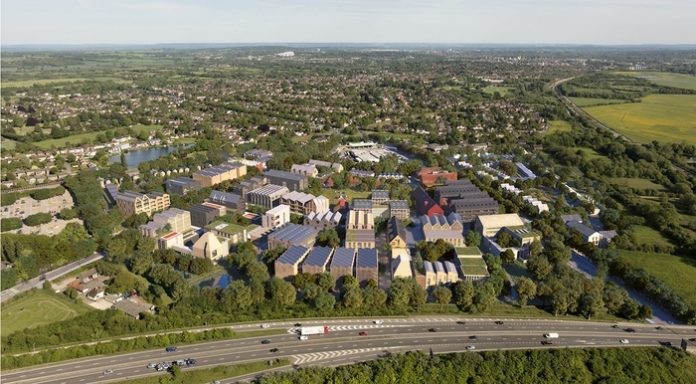Oxford City Council has granted planning permission for Oxford North proposed by Thomas White Oxford, the development company of St John’s College, to create a new life sciences district for Oxford, to include new laboratories and workspaces for biomedical science, new homes, public parks and neighbourhood shops, to retain and attract global science research talent and help boost the local and national economy.
Following Oxford City Council’s Planning Review Committee held on 19 December 2019 at which Members reviewed the details of the planning application and ultimately resolved to approve TWO’s planning application, positive discussions on the legal agreements have concluded with the City Council as the planning authority and Oxfordshire County Council as the highways authority.
The discussions have finalised the Section 106 Agreement to ensure that the planning proposals are integrated into the local community and the infrastructure needs have been addressed.
The project will release in order of £8 million of Community Infrastructure Levy over the life of the project, which Oxford City Council will administer for infrastructure projects in the local area including projects to be identified by Wolvercote community.
The S106 Agreement encapsulates TWO’s commitment to biodiversity, improved bus services connecting to Headington and Cowley, A40 and A44 improvements, including Peartree Interchange.
The project provides for a link road, public art, children’s play areas and safer routes to school, along with a guarantee of a minimum of 35% affordable housing.
The planning approval is for an outline consent for the overall 64-acre masterplan to provide 4,500 new jobs across circa 936,500 sq ft (87,000 sq m) of laboratories and offices, 480 new housing for circa 1,500 people, of which a minimum of 35%, the equivalent of 168, will be affordable homes, small shops, bars and restaurants, hotel, circa 23 acres of open spaces including three new parks, and significant investment into the walking, cycling, bus and highway networks.
Oxford North will boost the economy by circa £150 million per year.
A detailed consent has been granted for the first phase of development in the Central area, which will provide 140,000 sq ft (13,006 sq m) of laboratories and office space in three buildings along with the first phase of a new public park:
- The Red Hall will be a dynamic workspace for start-ups, entrepreneurs and freelancers, attracting spin-outs from Oxford University and Oxford Brookes University, with capacity for around 300 people to work collaboratively
- Two connected laboratory and workspace buildings totalling 55,000 sq ft (5,109 sq m) each over four floors, which will provide for life sciences businesses from SMEs to incubate and grow, up to global organisations looking to thrive within Oxford’s commercial ecosystem to develop ideas, collaborate and innovate.
A reserved matters application for the initial enabling works, which will include the earthworks and drainage, will be submitted shortly to Oxford City Council. Oxford City Council will carry out its own public consultation for this application. The first phase of new homes on the western Canalside portion of the site will be submitted in the summer.
Professor Andrew Parker, St John’s College said: “The news today that Oxford North has the green light is the culmination of many years of working collaboratively with Oxford City Council, and Oxfordshire County Council for highways, whose vision has been for the area to become home to a science and technology community, with much-needed new homes and vital infrastructure improvements. The College is heavily committed to creating a place, not just to facilitate life-enhancing science and technology discoveries, but a new district of Oxford where people want to live, visit and learn.
“Oxford North will connect and enhance the local area physically through open spaces, public art and culture, and immersive experiences. It will be a place for tomorrow’s workforce improving people’s lives, air quality and the environment while delivering a significant boost to the economy. We are proud to be investing in such a project for Oxford.”
William Donger, director, Thomas White Oxford added: “This is a significant day for Oxford’s future after many years of discussions to unlock a bold vision to transform the area to build a global innovation district for the city. We are committed to investing in a place that will enhance people’s quality of life, help to retain and attract Oxford’s remarkable talent and deliver positive socio-economic impacts.”
Charles Rowton-Lee, head of commercial agency, Savills Oxford said: “Currently in the market we know of very strong demand for new laboratories and grade A office accommodation totalling 1,275,000 sq ft. Oxford is a market where there is very low supply of any good quality space that is currently available. Furthermore, there are lease events between 2021 and 2024 allowing companies to move from existing space to alternative accommodation totalling 1,500,000 sq ft.
“With the success of the Oxford University Astra Zeneca vaccine and the soon to be opened Vaccine Manufacturing Innovation Centre at Harwell, we are seeing strong demand forming for inward investment, into Oxford, from around the world. University ‘spin outs’ account for a lot of this interest and companies wish to be associated with the high level of academia in the region.”
Works are already underway by Oxfordshire County Council for the wider A40 improvements between Wolvercote roundabout and Duke’s Cut. As part of the Oxford North proposal, this will see the transformation of the road into a tree-lined street with new bus stops, extended bus and cycle lanes, wider footpaths and safer crossing points, complementing Oxfordshire County’s wider strategy to deliver an outer ring of Park and Ride sites and express busways to the City.
Councillor Yvonne Constance, Cabinet Member for Environment at Oxfordshire County Council, said: “Oxfordshire County Council is supporting this work with a significant series of upgrades to the A40 to make cycling, walking and bus travel safe and attractive to residents as part of our overall commitment to the decarbonisation of the county.
“The Oxford North development is also a welcome way forward for the city; the design has sustainability included throughout to make it both an attractive place to work and live whilst having a very low environmental impact which the county backs.
“The inclusion of electric vehicle charging networks within the plans will also help to make this a sustainable development whilst helping us meet our target to become a net-zero carbon county.”
Nigel Tipple, chief executive, Oxfordshire Local Enterprise Partnership said: “The green light for such a significant project – that will have a positive impact on Oxfordshire’s economic recovery from the COVID-19 pandemic – is excellent news.
“As the local enterprise partnership for Oxfordshire, we want to ensure our county benefits from an infrastructure that is fit-for-purpose, supporting dynamic economic growth. With this in mind, we were delighted to have secured such a major Local Growth Fund allocation for this project and we are sure it can be a real asset for our communities and indeed, the wider ‘UK PLC’.”
Acting on behalf of Thomas White Oxford are Savills, Fletcher Priest Architects, Gardiner & Theobald LLP, Stantec, Townshend Landscape Architects, Hoare Lea, EDP, AKT II, BSG Ecology and Spacecraft Consulting.






















